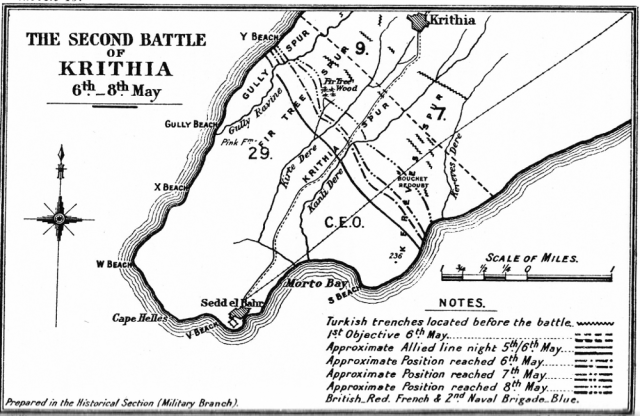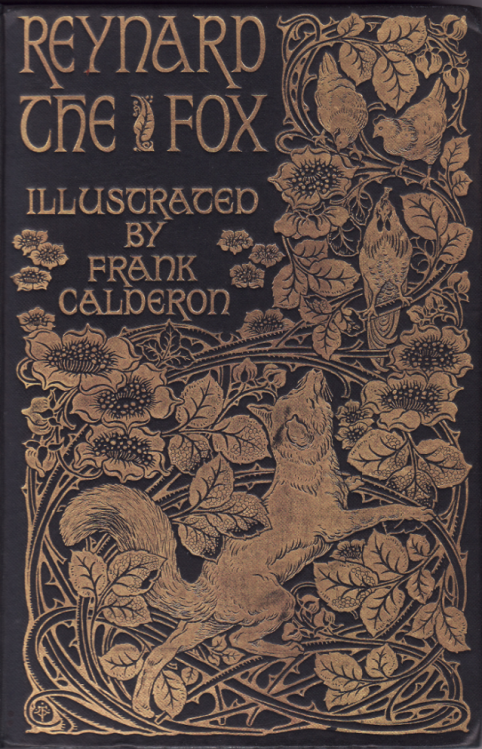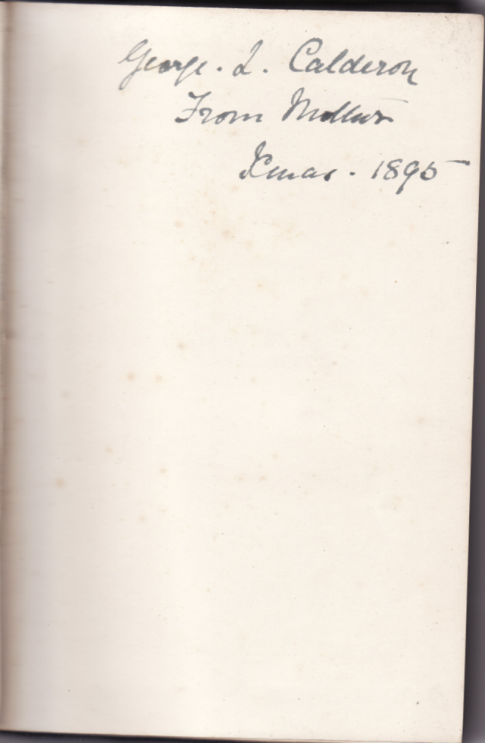Whilst writing Crime and Punishment Dostoevsky reminded himself in his notebook that he must ‘establish why Raskol’nikov killed the old woman’; although he had already suggested several reasons in the novel.
The question ‘why George Calderon insisted on signing up at the age of 45 and getting himself killed’ similarly bugs me, despite the fact that I have put forward a few reasons already. For instance, George is not known to have used the phrase ‘For King and Country’, but given his views on liberty, pluralism, social responsibility and the rule of law it seems obvious that he must at least have been fighting for the ‘British way of life’. Indeed, his father said that the Calderon family felt themselves utterly ‘English’, so it is quite possible to imagine George picking up a handful of earth and saying with Edward Thomas that he was fighting ‘literally, for this’. He simply felt he must defend his country.
Yet at a dinner party before the war, Laurence Binyon writes, George had ‘somewhat startled the company by maintaining that England never fought a war except for an idea’. Assuming Calderon still believed this, what this time was the ‘idea’? He did not hate Germans — he had a number of close colleagues in the history of religions who were German — but there is plenty of evidence in his letters that he hated the brutality of Prussian militarism and the amorality of the Hohenzollern system. Was he fighting, then, for decency, constitutional monarchy and liberal democracy? Certainly. And his awakened interest in his Spanish ancestors (see my posts of 18 October and 11 November 2014) even suggests that he saw himself as a Crusader for civilised values, although nowhere near as much as his friends saw him that way after the War.
More likely, I think, is that he believed he was fighting for an idea of the future. Not long after the party of 7 May, George wrote a letter to Leonora Bagg (see my post for that day). The letter is lost, but Bagg gave her own account of it:
The impression which I received […] was of one who felt and fully understood the vast impact of the world conflict in which he was giving his all, of one who had penetrated far below and beyond the material horror of the battles and felt the present phase of the conflict was a preface to a greater cataclysm to come which would transform the world. […] He felt that the vast majority had, comparatively speaking, the understanding of children of the conflict which was shaking the world to its foundations.
This sounds plausible, if one recalls the millenarianism of George’s views expressed in 1912 in the Cambridge Magazine and elsewhere. Surprisingly, perhaps, for a conservative thinker, George had looked forward then to a more classless society, more equal incomes, and an end to Edwardian ‘luxury’. Quite possibly he saw the present cataclysm as leading to a ‘New Age’ of that kind, with a more egalitarian and democratic European Order.
But one cannot deny (Kittie did not) that George was also seeking ‘Adventure’ in the War. ‘Adventure’ was the Edwardian male’s drug. It is a concept difficult for us to get our head round, because it seems to contain far more unassessed risk than we accept in ‘adventure’ today. With ‘Adventure’ went a bravery that sometimes seemed brainless. Certainly Calderon was fearless, but at Ypres he had also behaved foolhardily, irresponsibly. His determination to go where the fighting was fiercest is reminiscent of Peter Pan’s belief that ‘dying will be an awfully big adventure’. It seems almost a death wish.
‘Almost’. But what if it was not a form of parasuicide but a real desire for an ‘assisted’ suicide that would not look like suicide?
The reason George might do this was if he knew himself to be terminally ill. His close friend the dramatist St John Hankin had committed suicide in 1909 because he feared he had an hereditary disease of the nervous system, he did not want to become an invalid for decades like his father, and he felt he could not inflict his care on his own wife. In my view it is perfectly possible that George felt the same about Kittie. She had nursed her first husband for two years and after that George had witnessed her nursing her mother over years of decline. Perhaps he could not contemplate putting her through it again. Perhaps his own pride could not contemplate it. Moreover, his attitude to death itself was secular, Stoical, factual. In a condolence letter to Rothenstein on the latter’s father’s death, he used the word ‘euthanasia’ positively.
I do not like George’s ‘habitus’ on the group photograph in my post of 10 April. He looks drawn, uncharacteristically angular, humourless and grey. The only chronic illnesses we know he had suffered from in the past were gout (if it was that) and depression. Neither of them is mentioned by Kittie in her memoirs covering 1915. We know that what was at first diagnosed in Flanders in 1914 as gout was more expertly diagnosed later as inflammation of the prostate caused by days in the saddle. However, the description of George’s prostate that he was given by Surgeon-Major Pares after examination (see post of 28 October 2014) could well imply he had something more serious.
So was George aware something was not right with him, had seen a specialist at the beginning of 1915, say, and been told he was suffering from an untreatable cancerous process of the prostate? He was, of course, a man of great self-will, and he always felt he had the right to be secretive. Did he conclude that the way to ‘go’ was not years of invalidism, or active suicide, but by ‘suicide in battle’? It is a thinkable hypothesis, at least. It might explain why he was determined to go to the front line, rather than work in Intelligence, where, after reading George Aston’s Secret Service (1930), I believe with Coote Hedley he could have been very useful indeed.
The idea of a militarily delivered ‘suicide’ is an hypothesis that one can adduce several arguments to support (‘verify’), but none to definitively refute (‘falsify’), since even detailed medical records of the time (e.g. from Dr Tebb) could have missed the aggressive prostate cancer that only George’s private specialist might have diagnosed.
One of Chekhov’s favourite sayings, taken from his time as a medical student, was ‘if there are many remedies offered for a disease, it is probably incurable’. When questions like Dostoevsky’s about Raskol’nikov or mine about George suggest so many different answers, perhaps they are insoluble. They relate to acts; and the terms (contexts) in which one can see (interpret) acts may change through all futurity.
Next entry: Transfiguration and parting




























Transfiguration and parting
Today, 10 May 1915, which was a Monday, George and Kittie set out on the 140-mile journey by train from Gosport to the naval base of Devonport, where he was to embark for an unknown destination. Five other officers from the 9th Ox and Bucks had been called up for this mission, so perhaps they all travelled together, with their wives.
Although this was not set down until 1919, I think we can trust Kittie’s memory here.
The George Calderon she had known — wit, lover, Russianist, journalist, scholar, dramatist, adventurer, anthropologist, activist, entertainer — was once again becoming ‘someone different’, this time a person living ‘on another plane’. His transfiguration (Owen’s ‘Weep, you may weep, for you may touch them not’) had begun.
Or was he in the grip of a form of psychosis?
* * *
The party probably arrived at Devonport in the early afternoon. George and Kittie found a hotel, then George joined the others in barracks. Late in the afternoon, before the officers of the 9th Ox and Bucks and a draft of other soldiers left for the docks, George and Kittie were able to say goodbye at the barracks. We know from George’s letter of 16 May that an officer whispered in Kittie’s ear the name of the ship George was to sail in — the enormous Royal Mail Steamer Orsova. Probably, with other wives, she went down to the docks to catch a glimpse of him embarking or on deck.
* * *
At 11.00 p.m. this evening George wrote Kittie a three-page letter from the Orsova (this is the letter with ‘appling’, see my post of 22 January, about which I will report at a future date). As always on a voyage, he was exhilarated. He described the embarkation, the ship, the ‘delicate food’, with relish, and continued:
The Orsova had just cast off and was moving to its buoy. George addressed his letter to Kittie at Mrs Seymour’s in Brockhurst, and it left Devonport at 2.00 p.m. tomorrow.
He probably spells her name ‘Keety’ in imitation of the Russian pronunciation, e.g. of Kitty Levina in Anna Karenina.
Next entry: 11 May 1915